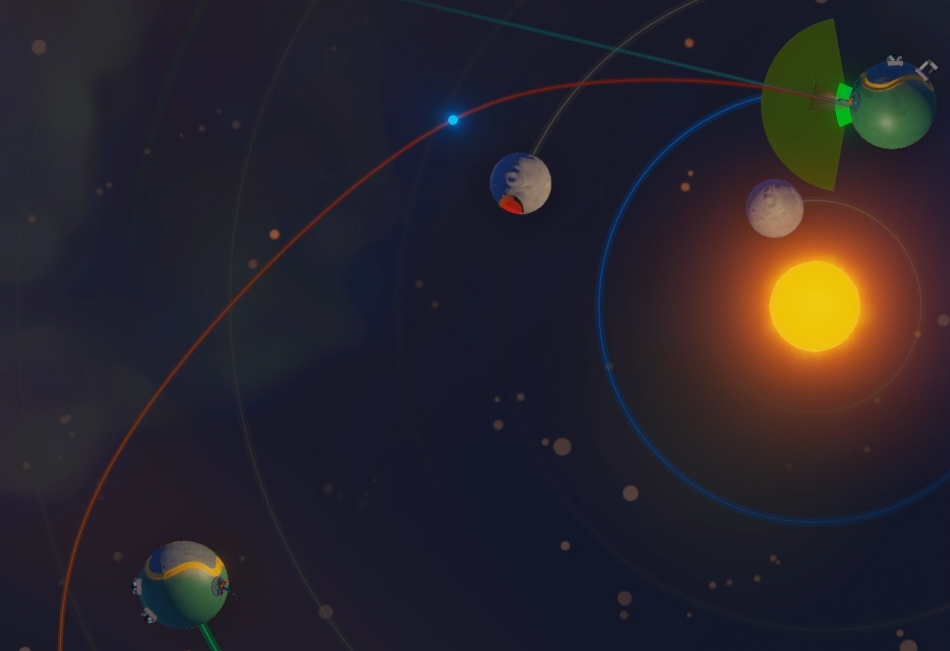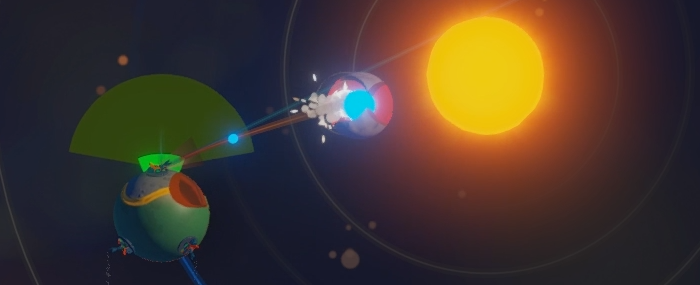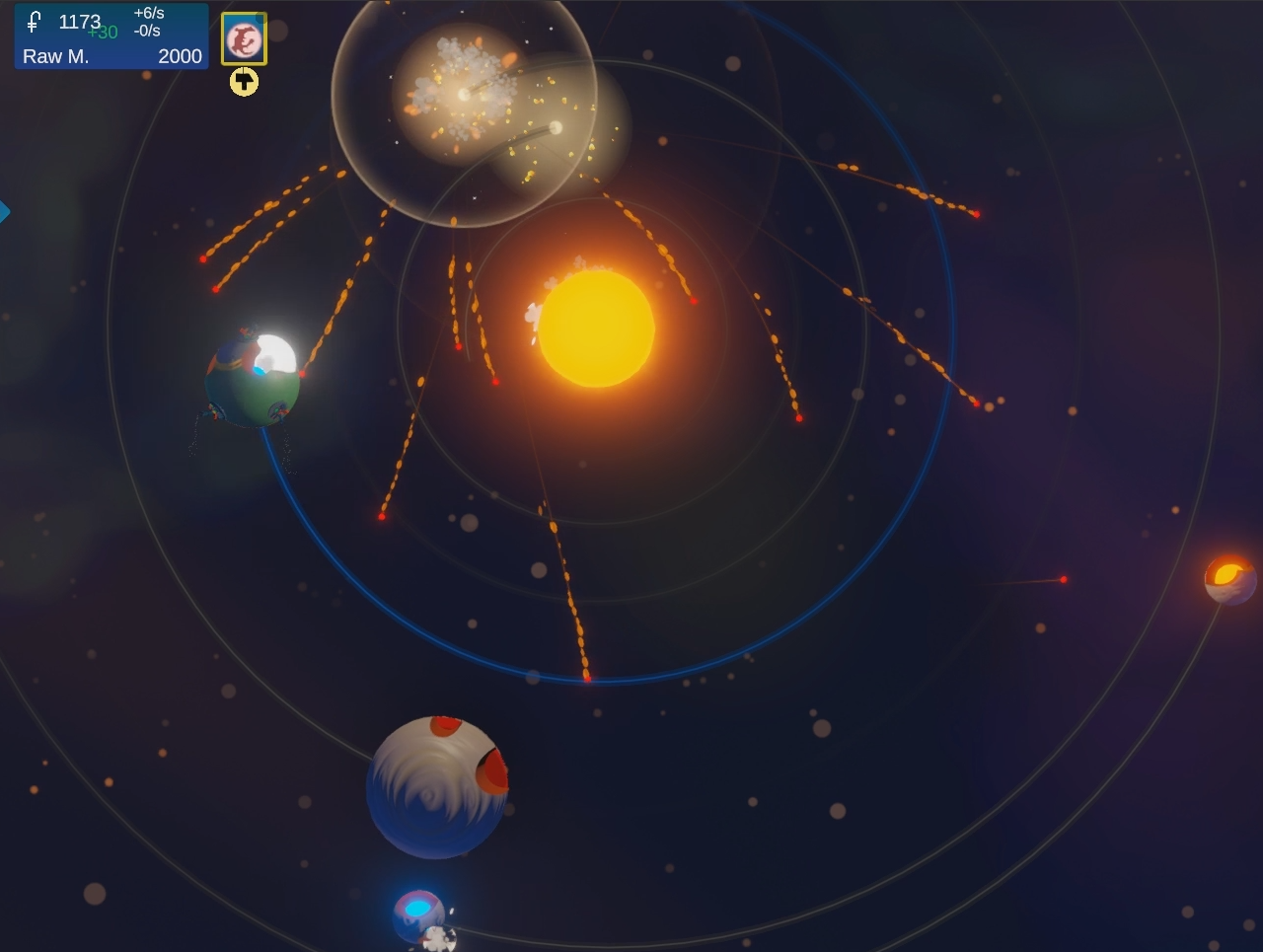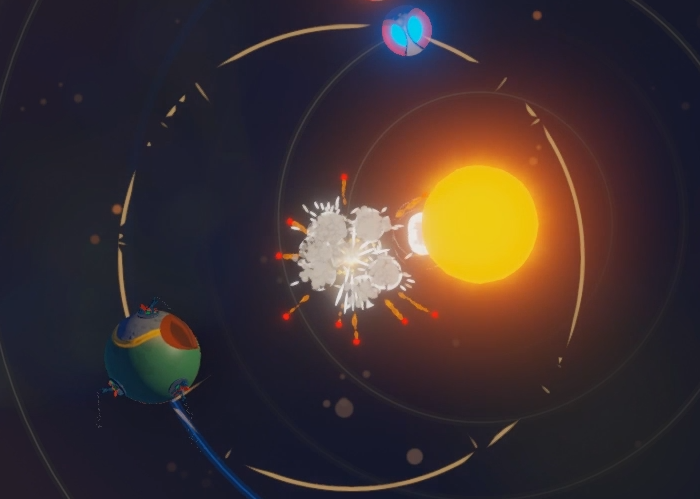Game Design guy Sasu, here! I’ll be popping by every now and then to write about this and that. Two weeks ago, we put out a short video showcasing some cosmic destruction in its early form. This devblog post was inspired by all that delicious carnage.
This is a bit of a continuation on our previous “Genesis of Worbital”-post, but I’d like to delve a bit deeper into one early decision that made Worbital what it is. The decision: to make the planets destructible.
One of the issues I had with our previous game, Interplanetary, was that firing shots at enemy planets didn’t give you a lot of satisfying feedback. You could see and hear the explosions, in addition to your event log letting you know that you just wiped out millions of innocent people, but it came out feeling a bit sterile due to the scale of it all. Interplanetary was made to be a relatively realistic take on space warfare, so it didn’t have the chance to go all crazy with planetary destruction. The player couldn’t see close-up damage, due to their viewpoint being on an interplanetary level. These were all understandable necessities for a more grounded game like Interplanetary, but I was left yearning for something more... fun.
So, one of the main pillars of Worbital, from the very birth of the idea, was to make the soil of the planets destructible. This one little mechanic went on to dictate a lot of major features in Worbital. Strangely appropriate, it was like a game design chain reaction.
1. Game Feel
The main benefit, of course, was that firing at planets would feel fun and rewarding. When you would hit a planet, we sure weren’t going to be subtle about it. Explosions, flying debris, lighting effects, molten cores, the works! This would also help players to intuitively realize that firing at planets is what you should be doing.
This also had a huge influence on the decidedly unrealistic feel of the game. As there’s a need to target specific spots on the planet surfaces, instead of just hitting the planets, targeting was made to work strictly on a 2D plane to keep up the pace of a match. It’s much faster and it’s much easier to keep track of the damage done to enemy planets when there’s no need to operate in 3D. The planets are also big and close to each other, eliminating the need for any “multi-stage close-up targeting mode” or anything like that. In Worbital, you simply take one glance to the enemy planet, draw your targeting trajectory where you want to fire, and let it rip.

We wanted to keep the basic mechanics simple and fun. While later weapons may have some advanced features, using them on a basic level is always easy.
2. Match Progression
Because of destructible terrain, each shot on your enemy planet counts. Even if you didn’t hit exactly where you were aiming at, you still managed to use the gravity to your advantage well enough to at least hit the planet. Each hit is therefore rewarded by damage on the enemy’s soil (unless they manage to block it somehow). Eventually, even the worst shots will chisel down the enemy planet.
This leads to the victory condition of Worbital. It was clear that the most satisfying way to win the game would be to blow up your enemies’ planets. To achieve that, we figured that you’d need to destroy just enough of the soil to reveal the planet’s core. Subsequently, hitting the core a few times would blow up the whole planet. Such a gratifying feeling!
The core would turn out to be another nifty trick to intuitively teach the player about the game. First they might destroy the planet surface just for the fun of it, but eventually, a pulsing, inviting glow would be revealed within. Who could resist firing a couple of shots at that?

A very skilled player might be able to manage to keep firing at one exact spot, creating a deep hole to reach the core with only a few shots. This was a great way of rewarding skillful play, emphasizing the more action-y focus of Worbital. At the same time, the amount of projectiles flying around would guarantee some hits here and there, taking the match towards its inevitable conclusion.
3. Cosmic Chaos
And lastly, we arrive to yet another pillar of Worbital, brought to us by planetary destruction: the unchained cosmic chaos!
When planets blow up, they leave behind debris that is flung through space, assisted by gravity. Imagine a myriad of small projectiles, flying around, hitting other planets. Those planets might even blow up. That’s more fragments, which is more explosions, which is more chaos. Then the sun blows up. You get the picture. It’s fun.
Worbital is unapologetically, a little bit random and crazy. While the chaos can be somewhat manageable, allowing you to try to control when planets blow up and how much debris they might leave behind, we’re primarily working according to the rule of fun. When testing out our early prototype with local gamers, the chaotic aspect of the game turned out to be a great success. There were screams and laughs, and generally, good times. We were a bit surprised, after previously working on a bit more serious game, that lot of the feedback wanted us to go crazier, even at the cost of a more balanced multiplayer experience. While we do try to keep things somewhat fair, this “just for kicks” attitude became an important and fun aspect of the development of Worbital. If it’s fun, put it in the game, worry later! It’s a bit scary sometimes too, to be honest…
And Many More...
I guess what I’m trying to say is, that in game design, seemingly independent components can have wild consequences on the rest of the game. It just depends on how you interpret and handle them. Worbital is like game development: often chaotic, but also rewarding and fun. Let’s just hope it will be more consistently fun and way less stressful!
Hope you enjoyed this burst of chaotic thoughts! Follow Worbital on Twitter or Facebook for easy reminders on future devblog posts!







